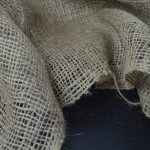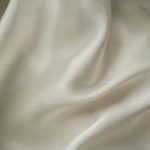Acetate fabric is made from cellulose treated with chemicals, making it smooth but potentially irritating if you have sensitive skin. You should know it’s flammable—it ignites quickly, burns brightly, and melts, raising burn risks near heat. Handling acetate requires low-heat ironing and gentle cleaning to avoid damage. Although not highly toxic, you might experience skin or respiratory irritation from fumes or residues. Keep these safety tips in mind, and you’ll find smarter ways to use or replace it.
Table of Contents
Key Takeaways
- Acetate fabric is produced from chemically modified cellulose, which may release irritant fumes when heated or freshly manufactured.
- It can cause skin irritation or allergic reactions in sensitive individuals, especially if untreated or new without washing.
- Acetate is highly flammable, igniting quickly and melting with a bright flame, increasing burn risks.
- Avoid exposure to open flames or high heat, and iron acetate at low temperatures using a pressing cloth.
- Safer alternatives include organic cotton, linen, hemp, and flame-resistant fabrics like wool, Nomex, or Kevlar.
What Is Acetate Fabric Made From?
Acetate fabric comes from cellulose, a natural substance found in plants like wood and cotton. When you wear acetate, you’re fundamentally in a fabric derived from plant fibers, giving it a smooth and silky feel.
This material is popular because it mimics the look and texture of silk but often costs less. You’ll find acetate in linings, dresses, and blouses due to its glossy appearance and ability to drape well.
Since it originates from a natural source, acetate blends some qualities of natural fibers with those of synthetics. Understanding its origins helps you appreciate why acetate behaves differently from pure natural fabrics and why it requires specific care to maintain its appearance and durability.
Chemical Composition and Production Process
Since the fabric comes from cellulose, its chemical makeup centers around cellulose acetate, a modified form of natural cellulose. You’ll find that cellulose acetate is created by reacting cellulose with acetic anhydride, which replaces some hydroxyl groups with acetate groups. This change alters the fiber’s properties, making it smoother and giving it that characteristic sheen.
During production, purified cellulose from wood pulp or cotton linters undergoes acetylation, then is dissolved in solvents to form a viscous solution. This solution is extruded through spinnerets to create fibers, which are then solidified, stretched, and cut.
The process allows you to enjoy fabric that’s lightweight and lustrous, but understanding these chemical steps is key to grasping why acetate behaves the way it does—especially when it comes to its safety characteristics.
Health Risks Associated With Acetate Fabric
You should be aware that acetate fabric’s chemical makeup can sometimes cause health concerns.
If you have sensitive skin, wearing acetate might trigger irritation or allergic reactions.
Let’s look closer at what causes these issues and how to protect yourself.
Chemical Composition Concerns
Although acetate fabric offers a luxurious feel and vibrant colors, it can pose certain health risks due to its chemical composition. Acetate is derived from cellulose combined with acetic acid and other chemicals during production.
Some residual solvents and chemicals may remain trapped in the fibers, which could release fumes or irritants, especially when heated. You should be aware that these chemicals might cause respiratory irritation or discomfort if you’re exposed to them frequently or in poorly ventilated spaces.
Additionally, the manufacturing process involves toxic substances that can impact the environment and workers’ health. While everyday use generally poses minimal risk, you should avoid prolonged inhalation of fumes from freshly manufactured acetate or garments exposed to high heat, as these can exacerbate chemical exposure concerns tied to acetate fabric.
Skin Sensitivity Reactions
How might acetate fabric affect your skin?
While acetate is generally considered safe, some people may experience skin sensitivity reactions. If you have sensitive skin, acetate can sometimes cause irritation, redness, or itching, especially when worn for extended periods.
This happens because acetate fibers may trap heat and moisture, creating a breeding ground for bacteria or allergens. You might also react to chemicals used in the manufacturing process if the fabric isn’t properly treated or washed before use.
To minimize risks, always wash new acetate garments before wearing them and avoid wearing them if your skin breaks out or feels uncomfortable.
If irritation persists, switch to natural fibers like cotton or linen, which tend to be gentler on sensitive skin.
Flammability Characteristics of Acetate
When exposed to an open flame, acetate fabric ignites quickly and burns with a bright, steady flame. You should know that its flammability is higher than many natural fibers like cotton or wool.
This means you need to be cautious when using or storing acetate near heat sources or open flames. The fabric melts as it burns, which can cause severe burns if it contacts your skin.
Here are key flammability characteristics of acetate fabric:
- Burns rapidly with a consistent, bright flame
- Melts and drips when ignited, increasing burn risk
- Produces a sweet, vinegar-like odor during combustion
Understanding these traits helps you recognize the risks involved with acetate fabric around fire.
Safe Handling and Care Tips for Acetate Fabric
Since acetate fabric can be highly flammable and sensitive to heat, you should handle it with care to maintain its appearance and safety. Avoid exposing it to open flames or high heat. When ironing, use a low temperature setting and place a pressing cloth between the iron and fabric. For cleaning, opt for dry cleaning or gentle hand washing with mild detergent to prevent damage.
Here’s a quick care guide:
| Care Tip | Action |
|---|---|
| Ironing | Use low heat with pressing cloth |
| Cleaning | Prefer dry clean or gentle hand wash |
| Storage | Keep away from direct sunlight and heat |
Following these tips will help you keep your acetate garments looking great and safe.
Alternatives to Acetate for Safer Use
If you’re looking for safer fabric options, consider non-toxic materials like organic cotton or bamboo.
You’ll also want to explore flame-resistant fabrics that offer added protection without harmful chemicals.
These alternatives can help you stay safe without sacrificing comfort or style.
Non-Toxic Fabric Options
Although acetate offers a smooth finish and affordability, you might want to reflect on non-toxic fabric options that provide safer alternatives without sacrificing comfort or style.
Choosing materials free from harmful chemicals can improve your health and reduce environmental impact. Here are some excellent non-toxic fabrics to reflect on:
- Organic Cotton: Grown without pesticides, it’s breathable and gentle on your skin.
- Linen: Made from flax fibers, linen is naturally hypoallergenic and durable.
- Hemp: A sustainable choice, hemp resists mold and requires minimal chemical treatment.
These options give you peace of mind while enjoying quality textiles.
Flame-Resistant Material Choices
When you need fabrics that prioritize safety, especially in environments prone to fire hazards, flame-resistant materials offer reliable protection that acetate lacks. These alternatives resist ignition and slow flame spread, keeping you safer. Here are common flame-resistant fabric choices you might consider:
| Material | Key Features |
|---|---|
| Nomex | High heat resistance; durable |
| Kevlar | Strong and heat-resistant |
| Modacrylic | Self-extinguishing; soft feel |
| Wool | Naturally flame-retardant |
| Proban-treated cotton | Chemically treated for safety |
Choosing these materials helps reduce fire risks in clothing or upholstery. You can rely on them in workplaces, uniforms, or home textiles where fire safety is essential. Unlike acetate, these fabrics give you peace of mind without sacrificing comfort or style.
Frequently Asked Questions
Can Acetate Fabric Be Recycled or Is It Biodegradable?
You can recycle acetate fabric, but it’s not widely accepted in regular recycling programs. It’s partially biodegradable, breaking down slower than natural fibers. So, you should consider eco-friendly disposal or repurposing to reduce waste.
How Does Acetate Fabric Compare to Polyester in Comfort and Durability?
You’ll notice acetate feels softer, with a silky touch, but it’s less durable than polyester, which lasts twice as long under heavy wear. So, if comfort’s key, choose acetate—but for toughness, polyester wins.
What Are Common Uses of Acetate Fabric in Fashion and Home Decor?
You’ll find acetate fabric commonly used in linings, dresses, and blouses for its silky feel. In home decor, it’s popular for curtains and upholstery, adding a smooth, lustrous finish that enhances any space beautifully.
Does Acetate Fabric Cause Allergic Reactions in Sensitive Individuals?
You’d think a smooth, silky fabric like acetate would be totally harmless, right? Well, it can cause allergic reactions in sensitive people due to chemicals used in processing. So, always test it on your skin first!
How Should Acetate Fabric Be Stored to Maintain Its Quality?
You should store acetate fabric in a cool, dry place away from direct sunlight to prevent fading and damage. Keep it folded or hung loosely to avoid creases, and avoid damp environments to maintain its quality.
- The Use of Nonwovens in Construction and Civil Engineering - July 11, 2025
- The Use of Nonwovens in Construction and Civil Engineering - July 11, 2025
- The Use of Nonwovens in Construction and Civil Engineering - July 11, 2025







